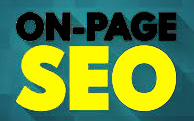What is On-Page SEO? || On-Page SEO || How to Optimize a Page and Drive Traffic
On-Page SEO: A Comprehensive Guide
In the digital age, having a website is essential for businesses, bloggers, and anyone looking to establish an online presence. However, simply having a website isn’t enough. To attract traffic and rank well on search engines, it's crucial to implement effective on-page SEO strategies. On-page SEO refers to the techniques used to optimize individual web pages to rank higher and earn more relevant traffic. This guide will explore various aspects of on-page SEO, including its importance, key elements, and best practices.
What is On-Page SEO?
On-page SEO involves optimizing both
the content and HTML source code of a webpage. It focuses on factors that are
within your control, unlike off-page SEO, which involves external factors like
backlinks. On-page SEO helps search engines understand the content of your site
and its relevance to users' queries.
Importance
of On-Page SEO
- Enhanced Visibility:
Proper on-page optimization helps search engines index and rank your site
effectively, making it easier for users to find your content.
- Improved User Experience: A well-structured website with high-quality content
enhances user experience, leading to lower bounce rates and higher
engagement.
- Higher Conversion Rates: By optimizing pages for specific keywords and user
intent, you can increase the likelihood of conversions, whether that’s
sales, sign-ups, or other desired actions.
- Mobile Friendliness:
With a growing number of users accessing the web via mobile devices,
optimizing your site for mobile is a crucial aspect of on-page SEO.
Key Elements of On-Page SEO
1. Title Tags
The title tag is one of the most
important on-page SEO elements. It tells search engines and users what the page
is about. Here are some tips for optimizing title tags:
- Include Primary Keywords: Use relevant keywords near the beginning of the
title.
- Keep it Concise:
Aim for around 60 characters to ensure it displays properly in search results.
- Make it Compelling:
Craft a title that attracts clicks while accurately reflecting the
content.
2. Meta Descriptions
Meta descriptions provide a brief
summary of the webpage content and appear in search results below the title.
While they don’t directly impact rankings, they influence click-through rates.
- Length:
Aim for 150-160 characters to avoid truncation.
- Include Keywords:
Incorporate relevant keywords naturally.
- Call to Action:
Encourage users to click by using actionable language.
3. Header Tags
Header tags (H1, H2, H3, etc.) help
structure your content and make it easier for both users and search engines to
understand. The H1 tag is typically reserved for the main title of the page.
- Use One H1 Tag:
Ensure that each page has a single H1 tag that includes the primary
keyword.
- Hierarchical Structure: Use H2 and H3 tags to create a logical flow of
information.
4. Keyword Optimization
Researching and using the right
keywords is fundamental to on-page SEO. Here’s how to optimize your content:
- Keyword Placement:
Use primary keywords in the title, first paragraph, and throughout the
content. However, avoid keyword stuffing.
- LSI Keywords:
Use Latent Semantic Indexing (LSI) keywords—related terms that help search
engines understand context.
5. Content Quality
High-quality content is paramount.
Here are some aspects to consider:
- Originality:
Create unique, valuable content that addresses user needs.
- Length:
While there’s no perfect length, longer content (typically 1,500+ words)
tends to perform better.
- Readability:
Use clear, concise language, bullet points, and images to enhance
readability.
6. URL Structure
A clean, descriptive URL structure
is beneficial for both users and search engines. Here are best practices:
- Descriptive URLs:
Use keywords in the URL that reflect the page content.
- Short and Simple:
Keep URLs concise and avoid unnecessary parameters.
7. Internal Linking
Internal links help distribute page
authority and guide users to related content on your site. They improve
navigation and user experience.
- Contextual Links:
Link to relevant pages within your content naturally.
- Use Descriptive Anchor Text: The clickable text should clearly describe the linked
page.
8. Image Optimization
Images enhance user engagement but
can slow down page load times if not optimized. Here’s how to optimize images:
- Descriptive Filenames:
Use relevant keywords in image filenames.
- Alt Text:
Provide descriptive alt text for images to improve accessibility and help
search engines understand the content.
9. Mobile Optimization
With mobile searches surpassing
desktop, ensuring your site is mobile-friendly is critical.
- Responsive Design:
Use a responsive design that adapts to different screen sizes.
- Page Speed:
Optimize loading times on mobile devices by compressing images and
minimizing code.
10. Page Speed
Page speed is a crucial ranking
factor. A slow-loading site can lead to higher bounce rates. To improve speed:
- Minimize HTTP Requests: Reduce the number of elements on a page.
- Enable Compression:
Use Gzip to compress files and improve load times.
- Leverage Browser Caching: Allow browsers to store certain elements for faster
retrieval.
Best Practices for On-Page SEO
- Regularly Update Content: Fresh content can improve rankings and keep your
audience engaged.
- Use Analytics Tools:
Utilize tools like Google Analytics to monitor performance and identify
areas for improvement.
- Stay Informed:
SEO trends change frequently. Keeping up with the latest practices and
algorithm updates is vital.
- Focus on User Intent:
Understanding what users are searching for and tailoring your content to
meet their needs is crucial for success.
Conclusion
On-page SEO is an essential part of a comprehensive digital marketing strategy. By focusing on key elements like title tags, meta descriptions, header tags, and high-quality content, you can enhance your website’s visibility, improve user experience, and ultimately drive more traffic. Remember that SEO is an ongoing process; continually assess and refine your strategies to stay ahead in the competitive online landscape.








No comments:
Post a Comment